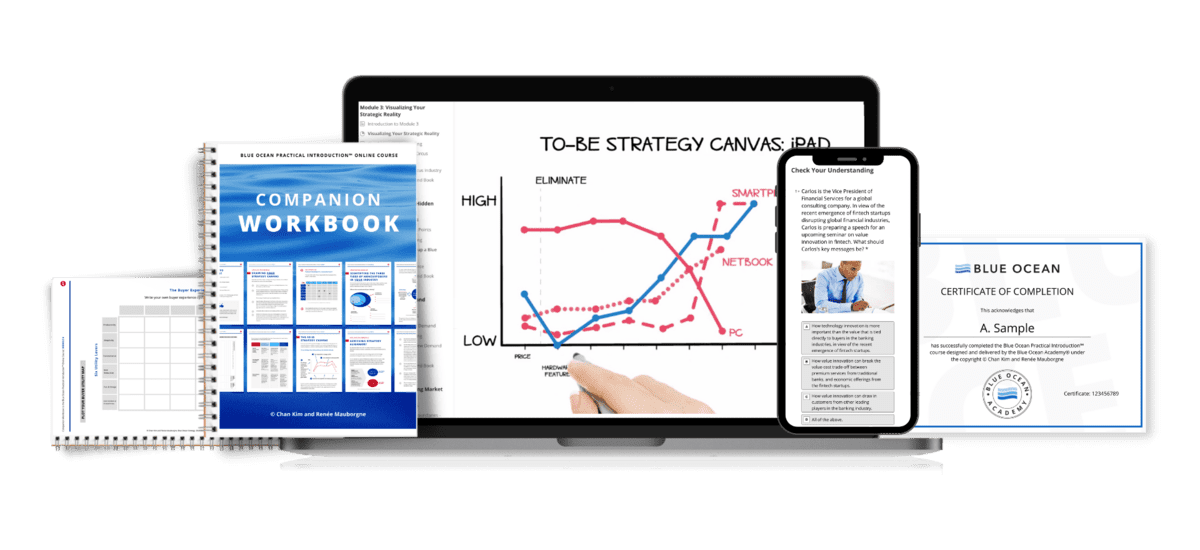PEIRCE COLLEGE
Peirce College’s blue ocean strategic move in the education industry pursued differentiation at low cost to unlock a huge catchment of noncustomers. It did so by looking across strategic groups in post-secondary education.
Peirce College is a private, non-profit college located in Philadelphia, Pennsylvania, U.S.A. Peirce was founded in 1865 to train the returning veterans of the American Civil War for participation in workforce expansion and economic development emerging from the Industrial Revolution. Peirce offered a practical curriculum focused on business, legal and technical education. Over the years, it shifted its focus from serving war veterans to educating traditional 18 to 21 year old students. By the late 1980s, the College had joined other regional colleges competing in the red ocean of post-secondary education. Despite a good regional reputation, Peirce College faced mounting challenges.
With the appointment of Arthur J. Lendo as the new President in 1991, Peirce aimed to swim out of the red ocean of me-too competition. Peirce started its journey of value innovation by looking at the unmet needs of noncustomers. Whereas most colleges were focusing on serving traditional-age students as Pierce was at the time, a vast pool of learners was overlooked or underserved. Working adults, for example, found it hard to complete an on-campus degree program while fulfilling their duties at work. Moreover, as adult learners mostly sought to improve their career prospects through enhancing their academic credentials, community and regional colleges that only offered associate degrees were less attractive to them. Traditional campus-based learning models also failed to suit the needs of military personnel and those who worked in employment sectors that required constant relocation. Finally, there existed a vast number of learners residing in other regions or even in foreign countries that Peirce never considered as its potential customers. Exploring the commonalities across these people provided Peirce with important insights for market reconstruction to pull in all-new demand.
Peirce reconstructed market boundaries by looking across strategic groups of post-secondary education. In the traditional market of undergraduate education, there were mainly two strategic groups: community and junior colleges that offered two-year associate degree programs and accredited colleges and universities that focused on offering four-year baccalaureate programs. As the internet age dawned, a new strategic group began to emerge: for-profit institutions offering online courses.
To create a leap in value and grow demand, Peirce drew on the distinctive strengths of these three strategic groups and eliminated or reduced everything else. That meant offering four year collegiate status and bachelor degree programs delivered through three completely interchangeable platforms: on campus (in Philadelphia); on-site (in corporate and community cluster locations); and online (over the Internet). Peirce Corporate and Community Clusters allowed students to attend Peirce College courses in corporate or community locations, and the online platform allowed for distance learning over the internet, a system used mainly by for-profit institutions at the time. With the same curricula and course syllabi, taught by the same professors, and yielding the same educational outcomes, students had the flexibility and convenience to move seamlessly among the three systems without geographical boundaries.
Compared with the traditional offerings of community and regional colleges, Peirce’s accredited programs, leading to bachelors’ degrees in practical areas catered better to the need of adult learners for career advancement and a year-round calendar satisfied adult learners’ needs for accelerated and flexible learning.
What’s remarkable is that Peirce managed to achieve these breakthroughs in value for learners at the lowest possible costs to the school and tuition for students. To fund the needed technological growth and development for delivering an unprecedented learning experience, Peirce diverted resources from those taken-for-granted areas of expenditure into areas that are central to a learner’s academic experience. To this end, the College eliminated and reduced unnecessary facilities and programs that were largely irrelevant to core academic activities. The Dean’s House was sold, and student dormitories and extracurricular programs were scaled down as they incurred considerable resources while adult learners did not benefit much from the offerings. Peirce further reduced costs through establishing strategic partnerships with third-party technology development firms. As the College borrowed less, it in turn achieved further cost savings due to reduced debt and interest payments. Peirce’s cost-effective business model facilitated one of the lowest private college tuition rates to students and has supported and sustained its delivery of other key value factors to a vast pool of adult learners.
Peirce’s blue ocean offering appealed to both existing customers of the college and to noncustomers. Beyond having access to vastly greater numbers of prospective students, the College unlocked new markets among active, reserves and retired military personnel as well as other employment sectors where relocation, and related disruptions to the educational process, are a significant challenge. Learners residing in more remote locations, with limited land-based educational options, emerged as an important constituency as did online community college students seeking a bachelor’s degree while juggling work/career responsibilities.
Positive results emerged quickly. Online enrollment forecasts were exceeded by 300 percent in the first year alone. The college achieved national scope with international reach in less than a decade. Total enrollments nearly tripled. The college enjoyed strong financial performance with a string of annual operating surpluses. This enabled the college to resource further expansion; increase scholarship funds; avoid borrowing; improve employee compensation; and maintain one of the lowest private college tuition rates. Average age of a Peirce student shifted from 21.5 to mid 30s. Today, Peirce offers a master’s degree program too.
The Peirce case study illustrates the transformative effect of undertaking a blue ocean strategic move.
PEIRCE COLLEGE
Peirce College’s blue ocean strategic move in the education industry pursued differentiation at low cost to unlock a huge catchment of noncustomers. It did so by looking across strategic groups in post-secondary education.
Peirce College is a private, non-profit college located in Philadelphia, Pennsylvania, U.S.A. Peirce was founded in 1865 to train the returning veterans of the American Civil War for participation in workforce expansion and economic development emerging from the Industrial Revolution. Peirce offered a practical curriculum focused on business, legal and technical education. Over the years, it shifted its focus from serving war veterans to educating traditional 18 to 21 year old students. By the late 1980s, the College had joined other regional colleges competing in the red ocean of post-secondary education. Despite a good regional reputation, Peirce College faced mounting challenges.
With the appointment of Arthur J. Lendo as the new President in 1991, Peirce aimed to swim out of the red ocean of me-too competition. Peirce started its journey of value innovation by looking at the unmet needs of noncustomers. Whereas most colleges were focusing on serving traditional-age students as Pierce was at the time, a vast pool of learners was overlooked or underserved. Working adults, for example, found it hard to complete an on-campus degree program while fulfilling their duties at work. Moreover, as adult learners mostly sought to improve their career prospects through enhancing their academic credentials, community and regional colleges that only offered associate degrees were less attractive to them. Traditional campus-based learning models also failed to suit the needs of military personnel and those who worked in employment sectors that required constant relocation. Finally, there existed a vast number of learners residing in other regions or even in foreign countries that Peirce never considered as its potential customers. Exploring the commonalities across these people provided Peirce with important insights for market reconstruction to pull in all-new demand.
Peirce reconstructed market boundaries by looking across strategic groups of post-secondary education. In the traditional market of undergraduate education, there were mainly two strategic groups: community and junior colleges that offered two-year associate degree programs and accredited colleges and universities that focused on offering four-year baccalaureate programs. As the internet age dawned, a new strategic group began to emerge: for-profit institutions offering online courses.
To create a leap in value and grow demand, Peirce drew on the distinctive strengths of these three strategic groups and eliminated or reduced everything else. That meant offering four year collegiate status and bachelor degree programs delivered through three completely interchangeable platforms: on campus (in Philadelphia); on-site (in corporate and community cluster locations); and online (over the Internet). Peirce Corporate and Community Clusters allowed students to attend Peirce College courses in corporate or community locations, and the online platform allowed for distance learning over the internet, a system used mainly by for-profit institutions at the time. With the same curricula and course syllabi, taught by the same professors, and yielding the same educational outcomes, students had the flexibility and convenience to move seamlessly among the three systems without geographical boundaries.
Compared with the traditional offerings of community and regional colleges, Peirce’s accredited programs, leading to bachelors’ degrees in practical areas catered better to the need of adult learners for career advancement and a year-round calendar satisfied adult learners’ needs for accelerated and flexible learning.
What’s remarkable is that Peirce managed to achieve these breakthroughs in value for learners at the lowest possible costs to the school and tuition for students. To fund the needed technological growth and development for delivering an unprecedented learning experience, Peirce diverted resources from those taken-for-granted areas of expenditure into areas that are central to a learner’s academic experience. To this end, the College eliminated and reduced unnecessary facilities and programs that were largely irrelevant to core academic activities. The Dean’s House was sold, and student dormitories and extracurricular programs were scaled down as they incurred considerable resources while adult learners did not benefit much from the offerings. Peirce further reduced costs through establishing strategic partnerships with third-party technology development firms. As the College borrowed less, it in turn achieved further cost savings due to reduced debt and interest payments. Peirce’s cost-effective business model facilitated one of the lowest private college tuition rates to students and has supported and sustained its delivery of other key value factors to a vast pool of adult learners.
Peirce’s blue ocean offering appealed to both existing customers of the college and to noncustomers. Beyond having access to vastly greater numbers of prospective students, the College unlocked new markets among active, reserves and retired military personnel as well as other employment sectors where relocation, and related disruptions to the educational process, are a significant challenge. Learners residing in more remote locations, with limited land-based educational options, emerged as an important constituency as did online community college students seeking a bachelor’s degree while juggling work/career responsibilities.
Positive results emerged quickly. Online enrollment forecasts were exceeded by 300 percent in the first year alone. The college achieved national scope with international reach in less than a decade. Total enrollments nearly tripled. The college enjoyed strong financial performance with a string of annual operating surpluses. This enabled the college to resource further expansion; increase scholarship funds; avoid borrowing; improve employee compensation; and maintain one of the lowest private college tuition rates. Average age of a Peirce student shifted from 21.5 to mid 30s. Today, Peirce offers a master’s degree program too.
The Peirce case study illustrates the transformative effect of undertaking a blue ocean strategic move.
THE BLUE OCEAN STRATEGY PRACTITIONER PROGRAM

Transform your strategic perspective, master blue ocean tools and frameworks, & learn to unlock new growth opportunities
Get started with new market creation with our live, interactive, expert-led program.


















